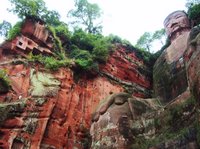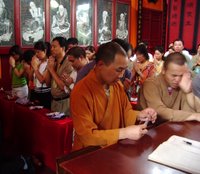This can be a trip of Buddhism education. 峨眉山 is one of the four major pilgrimage destinations, dedicated to Samantabhadra 普贤菩萨, the Buddha of truth and peace, (together with Putuo Mountain 普陀山 in Zhejiang 浙江 province for Avalokitesvara 观音菩萨, the Buddha of compassion; Wutai Mountain 五台山 in Shanxi 山西 for Manjusri 文殊菩萨, the Buddha of wisdom; Jiuhua Mountain 九华山 in Anhui 安徽 for Ksitigarbha 地藏菩萨, the Buddha of protection).
 The city of Leshan 乐山 is about 70Km south of Chengdu 成都. The Grand Buddha was sculptured (713-803 AD) out of the cliff 凌云山 at the confluence of three Rivers: 岷江, 大渡河, 青衣江, in order to protect the boats and their passengers. At 71m tall, with two 7m long ears and 8m wide feet, it's considered as the world's largest. Originally it had 13 stories of wooden worshiping temple. Long disappeared. The ancient walkway still exists on both sides of him (one way traffic now). Thousands of people queue up in order to walk down and admire his entire image. The wait can be 30 min - 1 hour. From the gate (¥70, half for students and seniors) to the top of the hill is quite pleasant (if not crowded). At the top, before and after your queue for the Buddha, you can pause at many tea houses and old pavilions. Our guide spent almost 2 hours on the procedures of the blessing ceremonies 开光 being taken place at Emei Mountain 峨眉山 (once every few years), and encouraged everyone to attend and purchase proper items to be blessed.
The city of Leshan 乐山 is about 70Km south of Chengdu 成都. The Grand Buddha was sculptured (713-803 AD) out of the cliff 凌云山 at the confluence of three Rivers: 岷江, 大渡河, 青衣江, in order to protect the boats and their passengers. At 71m tall, with two 7m long ears and 8m wide feet, it's considered as the world's largest. Originally it had 13 stories of wooden worshiping temple. Long disappeared. The ancient walkway still exists on both sides of him (one way traffic now). Thousands of people queue up in order to walk down and admire his entire image. The wait can be 30 min - 1 hour. From the gate (¥70, half for students and seniors) to the top of the hill is quite pleasant (if not crowded). At the top, before and after your queue for the Buddha, you can pause at many tea houses and old pavilions. Our guide spent almost 2 hours on the procedures of the blessing ceremonies 开光 being taken place at Emei Mountain 峨眉山 (once every few years), and encouraged everyone to attend and purchase proper items to be blessed. The next day, 峨眉山 (¥120, half for students and seniors). ¥60 bus goes from the gate 报国寺 to the cable car terminal. After the lift ¥40, we reached the main worship spot, Wannian Temple 万年寺, halfway up the slope. Many of our fellow tourist applied for blessing here. It was a "mass production". Every session took around 10 minutes, about 30 people at a time. The monk walked by everyone chanting, sprinkled water at the object to be blessed and the head of the believers. At the side, a row of monks kept order, counted donations (¥50 a piece) and wrote down the names of the doners.
The next day, 峨眉山 (¥120, half for students and seniors). ¥60 bus goes from the gate 报国寺 to the cable car terminal. After the lift ¥40, we reached the main worship spot, Wannian Temple 万年寺, halfway up the slope. Many of our fellow tourist applied for blessing here. It was a "mass production". Every session took around 10 minutes, about 30 people at a time. The monk walked by everyone chanting, sprinkled water at the object to be blessed and the head of the believers. At the side, a row of monks kept order, counted donations (¥50 a piece) and wrote down the names of the doners.  万年寺's main temple is brick, no supporting columns. It houses a big bronze statue of Samantabhadra 普贤菩萨 sitting on an 6-toothed elephant. Due to its large scale, scholars are still debating on how the statue was made and hauled up here.
万年寺's main temple is brick, no supporting columns. It houses a big bronze statue of Samantabhadra 普贤菩萨 sitting on an 6-toothed elephant. Due to its large scale, scholars are still debating on how the statue was made and hauled up here.We didn't go for the summit, as the temple up there was in remodeling. On our way down from 万年寺, a group of monkeys came and tried to steal food from the tourists. But when we went to the monkey view area, not a single one was to be found. However, it was the most enjoyable walk in these two days. Very scenic all the way accompanied by a creek.
We joined another tour group for this trip. This time it was a mistake. The tour guides constantly pushed products: 3 shopping stops on the first day: a factory showroom of crystal, a jade store associated with the provincial tourism bureau that sells Buddha pendants, and a foot massage parlor that sells high-priced Tibetan medicine. Each was filled with people, parking lots full of tour buses. The 2nd day, a tea shop and traditional medicine stalls.